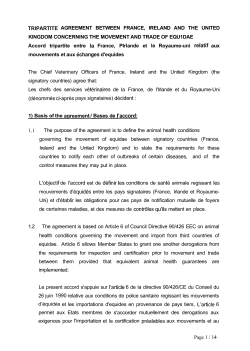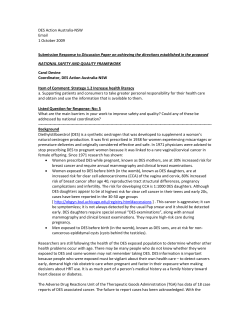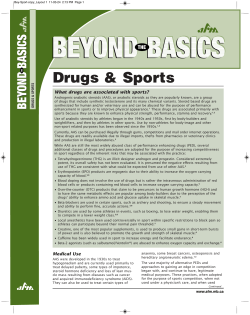
www.kup.at/urologie Homepage: Online-Datenbank mit Autoren- und Stichwortsuche
Androgens and the risk of cardiovascular disease Crook D Journal für Urologie und Homepage: Urogynäkologie 2000; 7 (Sonderheft www.kup.at/urologie 1) (Ausgabe für Schweiz) Online-Datenbank mit Autoren- und Stichwortsuche Indexed in Scopus Member of the P . b . b . 0 2 Z 0 3 1 1 1 6 M , www.kup.at/urologie V e r l a g s p o s t a m t : 3 0 0 2 P u r k e r s d o r f , E r s c h e i n u n g s o r t : 3 0 0 3 G a b l i t z D. Crook ANDROGENS AND THE RISK OF CARDIOVASCULAR DISEASE Summary Conventional wisdom, arising from over 50 years of research, holds that estrogens reduce the risk of diseases such as myocardial infarction and stroke whereas androgens increase this risk. At a time when the claimed arterial benefit of estrogen is being strongly challenged by the recent failure of several placebocontrolled studies of vascular endpoints, it is timely to reconsider the likely cardiovascular impact of androgen Zusammenfassung Nach 50 Jahre laufender Forschung auf dem Gebiet der Sexualhormone wird allgemein angenommen, daß Östrogene sowohl das Herzinfarkt-, als auch das Schlaganfallrisiko reduzieren, während Androgene dieses Risiko erhöhen. Mehrere erfolglose placebokontrollierte Studien in jüngster Zeit lassen nun an den angenommenen Vorteilen der Östrogene Zweifel aufkommen. Es ist daher an der Zeit, die wahrscheinlich kardiovaskulären Wirkungen einer Androgen-Therapie bei alternden Männern neu zu überdenken. Das negative Résumé 50 années de recherche amènent à prétendre communément que les estrogènes réduisent le risque de maladies telles que l’infarctus du myocarde et l’attaque d’apoplexie tandis que les androgènes les font monter. Maintenant que les prétendus avantages artériels des oestrogènes sont vraiment contestés en raison des récents échecs de plusieurs études contrôlées placebo, il est temps de reconsidérer l’éventuel impact cardiovasculaire d’une thérapie androgénique chez l’homme âgé. L’image négative des androgènes INTRODUCTION The issue of androgen therapy in aging men has for some time been clouded by disagreement over the existence of a hypogona- ANDROGENS AND THE RISK OF CARDIOVASCULAR DISEASE therapy in aging men. The negative image of androgens results in part from inappropriate extrapolation from studies of athletes using combinations of high doses of illicit steroids without medical supervision. Androgenic changes in the plasma lipoprotein profile involve a mixture of changes thought to be good and changes thought to be bad. Likewise, the ability of androgens to increase plaque size seen in fat-fed monkeys is accompanied by potentiallybeneficial changes in lumen volume (due to arterial remodelling) and vascular reactivity. Testosterone dilates coronary arteries and in short-term studies has proved useful in treating arterial disease. Men with high plasma testosterone concentrations are at low, not high, risk of arterial disease. Such contradictions need to be resolved in placebo-controlled clinical trials, most realistically using newly-developed techniques for non-invasive monitoring of plaque structure and composition. Bild der Androgene stammt von der nicht gerechtfertigten Extrapolation aufgrund von Studien an Sportlern, die ohne ärztliche Kontrolle von Kombinationen hochdosierter verbotener Sexualhormone Gebrauch gemacht haben. Androgene Veränderungen des Lipoprotein-Profils im Plasma bringen verschiedene für gut oder schlecht gehaltene Veränderungen mit sich. Ebenso geht die Fähigkeit der Androgene, die Plaque zu vergrößern, laut Beobachtungen bei fettgefütterten Affen, eventuell mit vorteilhaften Veränderungen im Lumenvolumen (aufgrund von Gefäßveränderungen) und einer arteriellen Reaktivierung einher. Das Testosteron erweitert die Herzkranzgefäße und hat sich in Kurzzeitstudien als Therapie arterieller Erkrankungen bewährt. Männer mit einem hohen Testosteron-Wert im Plasma haben nicht ein hohes, sondern ein niedriges Risiko, eine arterielle Erkrankung zu erleiden. Solche Widersprüche bedürfen der Klärung durch placebokontrollierte klinische Studien, am realistischsten durch den Einsatz neuester Techniken für die nichtinvasive Überwachung der Struktur und der Zusammensetzung der Plaque. provient en partie de l’inopportune extrapolation à partir d’études faites sur des athlètes consommant des combinaisons de stéroïdes prohibés à dose élevée et sans contrôle médical. Les modifications androgéniques dans le profil lipoprotéinique du plasma entraînent un ensemble de modifications, certaines considérées comme bonnes, d’autres considérées comme mauvaises. Ainsi la faculté des androgènes à augmenter l’ampleur de la plaque athéromateuse chez des singes engraissés s’accompagne de changements éventuellement bénéfiques sur la lumière artérielle (en raison d’un remodelage artériel) et d’une reprise de la souplesse vasculaire. La testostérone dilate les artères coronaires, et des études à court terme ont prouvé son efficacité dans le traitement des maladies artérielles. Les hommes ayant un taux plasmique de testostérone élevé sont exposés à un risque faible et non élevé de maladie artérielle. Il importe d’élucider de telles contradictions par des études cliniques contrôlées placebo en utilisant les techniques les plus réalistes possible de contrôle non invasif de la structure et de la composition de la plaque athéromateuse. dal state analogous to postmenopausal hypo-estrogenemia. Recent years have seen the realisation that increased lifespan carries with it the prospect of many decades of old age for men, accompanied not only by physical burdens – such as osteoporosis and heart disease –, but also more general issues of cognitive decline and loss of well-being. In many societies aging women now take estrogens and other steroid hormones in order to improve their physical and mental well-being. Androgen J. UROL. UROGYNÄKOL. Special Edition 1/2000 19 ANDROGENS AND THE RISK OF CARDIOVASCULAR DISEASE therapy in the aging male may well be of similar benefit. If, as is likely, such therapies move out of the private clinic and into the public domain then the risk/ benefit ratio needs to be clarified. The major causes of mortality and morbidity in men living in industrialised societies are myocardial infarction and stroke. Steroid hormones have been linked to the pathogenesis of both conditions. In the context of women’s health these are major areas of controversy: older oral contraceptive formulations were thought to increase the risk of arterial disease, whereas postmenopausal estrogen therapy is claimed to reduce this risk. In neither case is there a consensus of opinion and indeed recent placebo-controlled trials of estrogen replacement therapy show a pattern of increased risk in the early years of treatment. That such controversies persist despite tens of millions of women being treated with such steroids, often for decades, is a cautionary tale for those wishing to evaluate the cardiovascular effects of androgen therapy in the aging male. THE PERCEPTION OF ANDROGENS AS ATHEROGENIC STEROIDS The gender difference in arterial disease seen before the age of 50 years men, but this could equally be due to protective effects of estrogen, or to adverse effects of other aspects of masculinity, such as personality type or lifestyle. Overall the gender difference in arterial disease dictates that the effect of androgen therapies be taken seriously, but the idea that such therapies must increase the risk of arterial disease is unsustainable. Reports of arterial disease in athletes abusing anabolic androgenic steroids The media have a fixation that anabolic androgenic steroids (AAS) cause heart disease. The death (age 38 y) of the USA sprinter Florence Griffith-Joyner, whose 100 m and 200 m sprint world records still stand after 12 years, continues to be promoted as a cautionary tale of AASinduced ‘heart disease’ even though her autopsy clearly showed suffocation due to epilepsy, with no arterial pathology. In the USA the prevalence of AAS abuse ranges from 38–55 % of bodybuilders through 15–20 % of college athletes and, most alarmingly, perhaps 10 % of male high school students. However, sports science researchers have been unable to find the predicted epidemic of arterial disease. Even if such a problem could be identified, the relevance of such findings to the much lower doses of steroids used under medical supervision in the aging male is questionable. Premenopausal women are less likely to suffer from arterial disease than are age-matched 20 J. UROL. UROGYNÄKOL. Special Edition 1/2000 Changes in risk factors for atherosclerosis Androgens can increase plasma concentrations of low density lipoproteins (LDL) and decrease those of high density lipoproteins (HDL). Neither effect is considered desirable, although only minor changes are seen with current therapies. In the case of HDL, research in this laboratory and others suggests that steroids that reduce HDL concentrations do not necessarily impair HDL functions such as promotion of cholesterol efflux from cells. Indeed the recent identification of HDL receptors such as scavenger receptor B1 (SR-B1) raises the possibility that reducing HDL concentrations by some mechanisms might even be beneficial. It is noteworthy that one of the most widely recommended strategies to prevent arterial disease – a lowfat diet – reduces HDL concentrations. A further complication is that population studies consistently show that it is the man with low plasma testosterone concentrations who has the low HDL concentrations. High-dose androgens given to female-to-male transsexuals impair the flow-mediated response of brachial arteries (proposed as a surrogate for arterial disease), perhaps involving an effect on endothelin1. This finding needs investigation in men treated with lower-dose therapies: there may be a gender difference in the arterial response to androgens. Other potentially adverse effects of androgens need to be considered, such as the claim of increased monocyte adhesion to cultured endothelial ANDROGENS AND THE RISK OF CARDIOVASCULAR DISEASE cells treated with dihydrotestosterone, linked to an effect on the expression of vascular cell adhesion molecule-1 (VCAM-1), and also a report that androgens interfere with thromboxane metabolism. Induction of atherosclerosis in experimental animal models Studies in fat-fed cynomolgous monkeys treated with androgens show an increase in plaque size. Interpretation of these data is problematical as in one study there was concomitant remodelling of the arterial wall to maintain lumen volume and in the other the vasomotor responses to acetylcholine stimulation were improved. Both sets of investigators chose to study female animals exclusively. Studies in male animals, and in the newer transgenic models of atherosclerosis, are needed. MIGHT ANDROGENS HAVE BENEFICIAL EFFECTS ON ARTERIAL DISEASE? Androgens have been used to treat arterial disease for over fifty years. Testosterone induces coronary artery dilatation and increases coronary blood flow in men with established coronary artery disease. Men with naturally high plasma testosterone levels are at less risk of diseases such as dyslipidemia, coronary heart disease, hypertension, and stroke, compared to those with low levels. In the fat-fed rabbit model of atherosclerosis intramuscular injections of testosterone enan- David Crook, PhD Present appointment: Senior Research Fellow, Department of Cardiovascular Biochemistry, St Bartholomew’s and The Royal London School of Medicine. Previously (1986–1996) Laboratory Director and Lecturer at the Wynn Division of Metabolic Medicine, Imperial College School of Medicine at the National Heart and Lung Institute, London, UK. Postdoctoral research training at the The Gladstone Foundation Laboratories for Cardiovascular Disease, University of California, San Francisco, California, USA; at St Thomas’ and St Mary’s Hospital Medical Schools, London, UK. Research interests: The influence of sex hormones (estrogens, androgens, progestogens) and related steroids on plasma lipoproteins and other risk markers for vascular disease; the role of small, lipid-poor pre-b mobility HDL in atherogenesis; the role of lipoprotein(a) as an acute-phase reactant. Publications: over 50 peer-review and over 100 non-peer review papers on steroid hormones, plasma lipoproteins and atherosclerosis. Address for correspondence: David Crook PhD Senior Research Fellow, Department of Cardiovascular Biochemistry, St Bartholomew’s and The Royal London School of Medicine Charterhouse Square, London EC1M 6BQ, UK e-mail: dcrook@mac.com thate inhibited aortic atherosclerosis. The effects of androgens on LDL and HDL concentrations must be considered in the light of theoretically beneficial effects, such as the reduction in those of triglycerides and lipoprotein(a) and the improvement in fibrinolysis. In hypogonadal men testosterone therapy has been linked to an improvement in insulin sensitivity and visceral fat mass, although the evidence that such changes are seen in healthier individuals is weak. THE FUTURE The current evidence base is often confusing but at a minimum holds out the potential for androgens, like estrogens, to prevent myocardial infarction and stroke. There is a need for placebo-controlled studies in healthy men during chronic lowdose androgen administration. Investigation of myocardial infarction and other ‘hard’ J. UROL. UROGYNÄKOL. Special Edition 1/2000 21 ANDROGENS AND THE RISK OF CARDIOVASCULAR DISEASE endpoints would cost hundreds of millions of dollars. Instead, consideration should be given to a collaborative study using the endpoint of non-invasive imaging of arterial plaques. Such studies can be of three or four year’s duration and involve hundreds, rather than thousands, of men. The pace of development of technologies such as magnetic resonance imaging and computerenhanced ultrasound is rapid and 22 they may soon provide an acceptable alternative to the clinical endpoints of interest to those involved in men’s health. Further Reading: Godsland IF, Wynn V, Crook D, Miller NE. Sex, plasma lipoproteins and atherosclerosis: prevailing assumptions and outstanding questions. Am Heart J 1987; 114: 1467–503. Sullivan ML, Martinez CM, Gennis P, Gallagher EJ. The cardiac toxicity of J. UROL. UROGYNÄKOL. Special Edition 1/2000 anabolic steroids. Progress Cardiovasc Dis 1998; 41: 1–15. Alexandersen P, Haarbo J, Christiansen C. The relationship of natural androgens to coronary heart disease in males: a review. Atherosclerosis 1996; 125: 1–13. Von Eckardstein A. Androgens, cardiovascular risk factors and atherosclerosis. In: Nieschlag E, Behre HM (eds). Testosterone. Springer, Berlin, 1998; 229–58. Crook D. Androgens and the risk of cardiovascular disease. Aging Male 2000; 3 (Suppl 2): 1–7. NEUES AUS DEM VERLAG Abo-Aktion Beziehen Sie die elektronischen Ausgaben unserer Zeitschriften kostenlos. Die Lieferung umfasst 4–6 Ausgaben pro Jahr zzgl. allfälliger Sonderhefte. Unsere e-Journale stehen als PDF-Datei (ca. 5–10 MB) zur Verfügung und sind auf den meisten der marktüblichen e-Book-Readern, Tablets sowie auf iPad funktionsfähig. P P Bestellung kostenloses e-Journal-Abo Besuchen Sie unsere zeitschriftenübergreifende Datenbank Bilddatenbank P Artikeldatenbank P Fallberichte Besuchen Sie unsere Rubrik Medizintechnik-Produkte P MediTEX IVF Critex GmbH Zestica™ Kairos Life Science GmbH MEA-getestete Verbrauchsmaterialien Gynemed GmbH Inkubator Labotect GmbH Steripette MTG Medical Seaforia™ Origio GmbH OvulaRing Gynial GmbH Philips Clear Vue 650 Mides GmbH Xario 200 Toshiba Medical Systems
© Copyright 2025





















